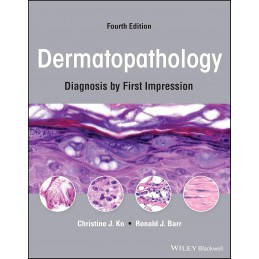- Obniżka


 Dostawa
Dostawa
Wybierz Paczkomat Inpost, Orlen Paczkę, DHL, DPD, Pocztę, email (dla ebooków). Kliknij po więcej
 Płatność
Płatność
Zapłać szybkim przelewem, kartą płatniczą lub za pobraniem. Kliknij po więcej szczegółów
 Zwroty
Zwroty
Jeżeli jesteś konsumentem możesz zwrócić towar w ciągu 14 dni*. Kliknij po więcej szczegółów
The most up-to-date edition of a pattern-based dermatopathology atlas
In Dermatopathology:: Diagnosis by First Impression, an expert team of dermatopathologists deliver an authoritative guide to the microscopic differentiation of visually similar dermatological diseases that is useful for both trainees and practicing physicians. This latest fourth edition includes new sections on alopecia and immunohistochemistry as well as over 100 new photomicrographs for a total of almost 1000 high-resolution and annotated figures.
The “Key Differences” pages walk the reader through the identification of distinctive diagnostic features, and disease-based and alphabetical indexes make it simple to quickly locate necessary information. Unique amongst dermatopathology atlases, this book remains organized by microscopic pattern???as opposed to disease category???which makes it the perfect companion for slide analysis. It also offers self-assessment questions and algorithms for pattern analysis, as well as::
A visual feast for practicing dermatologists and pathologists, Dermatopathology:: Diagnosis by First Impression will also earn a place in the libraries of trainees.
Opis
Preface, viii
Acknowledgments, ix
About the Companion Website, xi
Introduction, 1
Chapter 1 Shape on Low Power, 23
Epidermis
Regular acanthosis, 25
Lobular proliferation, 29
Reticulated proliferation, 35
Central pore, 42
Epidermal perforation, 46
Dermis
Circular islands, 49
Cords/tubules and comma shapes, 53
Space with a lining, 59
Papillations, 70
Polypoid (dome-shaped), 77
Square/rectangular, 82
Palisading reactions, 88
Pseudoepitheliomatous hyperplasia above abscesses, 95
Pink ball, (see Chapter 6)
Chapter 2 Gestalt: Rash/inflammatory, 99
Epidermal changes
Parakeratosis, 101
Spongiosis, 104
Papulosquamous (psoriasiform), 108
Interface (vacuolar), 114
Interface (lichenoid), 119
Inflammation: Specific patterns and cell type
Epidermal eosinophils, 125
Perivascular, 129
Band-like dermal/papillary dermal infiltrate, 133
Diffuse/nodular, 139
Subcutaneous, 146
Chapter 3 Cell Type, 153
Melanocytic, 155
Spindle cells, 168
Pleomorphic cells, 186
Epithelioid vs spindle vs pleomorphic cells, 187
Endothelial, 188
Giant, 202
Clear, 212
Chapter 4 Top-Down, 229
Arthropods, 231
Hyperkeratosis/parakeratosis, 237
Upper epidermal change, 244
Acantholysis, 254
Subepidermal space/cleft, 264
Granular “material” in cells, 271
“Busy” dermis, 276
Dermal material, 279
Fat necrosis, 292
Chapter 5 Color – Blue, 295
Blue tumor, 297
Lymphocytes, 307
Mucin and glands or ducts, 315
Mucin, 319
Chapter 6 Color – Pink, 327
Pink ball of spindle cells, 329
Pink material, 332
Pink dermis, 339
Epidermal necrosis, 341
Chapter 7 Miscellaneous, 347
Alopecia, 349
Immunohistochemistry, 354
Index (Pattern), 361
Index (Histological Category), 366
Index (Alphabetical), 369
Indeks: 19333
Autor: Rafał Stec
